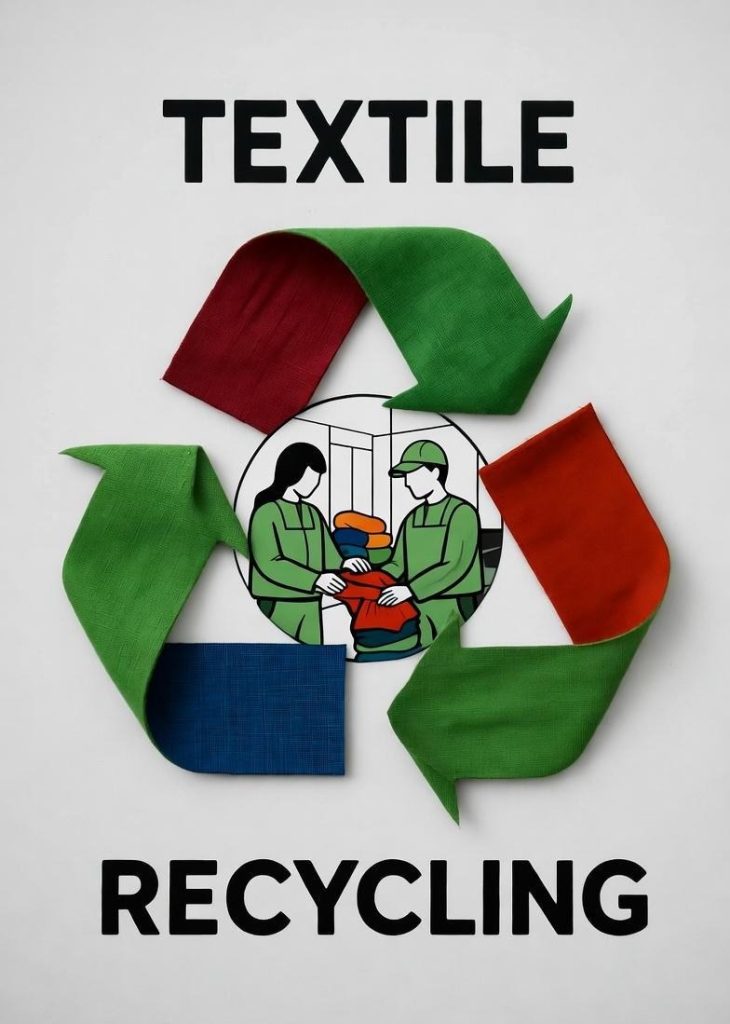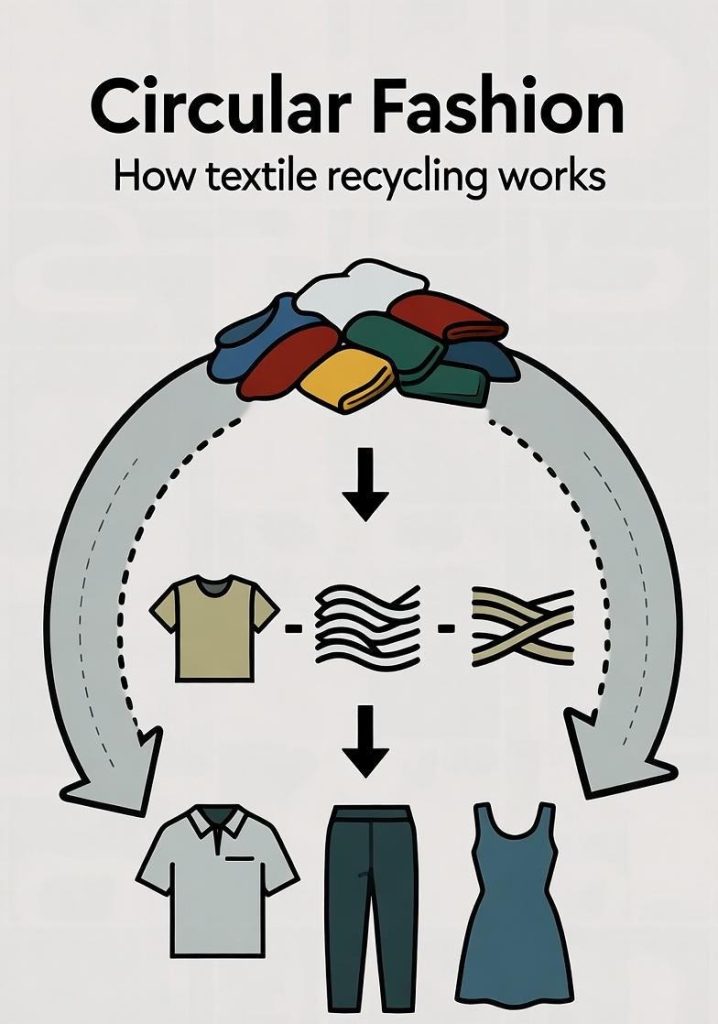
Introduction: The Hidden Cost of Our Clothes
The modern fashion industry has built its empire on speed, style, and disposability. Every year, millions of tons of garments are produced, sold, and discarded at a pace our planet simply cannot sustain. Behind every new collection and online sale, there’s an invisible mountain of waste — and a growing illusion that recycling alone can save us.
“Circularity” has become the buzzword of sustainability campaigns. But beneath the glossy marketing lies a complex reality: most textile recycling today doesn’t close the loop — it merely delays the inevitable. This article explores that illusion and examines what true circularity really looks like — not as a slogan, but as a science-backed, systemic transformation.
- The Scale of the Textile Waste Crisis
The numbers are staggering. Globally, over 90 million tons of textile waste are generated each year, and more than 90% of it ends up being incinerated or buried in landfills. That’s roughly 11 million tons of clothing entering the ground annually — materials that could have been reused, repurposed, or properly recycled.
This isn’t just a manufacturing issue. It’s a consumption crisis — fueled by overproduction, fast fashion, and our cultural obsession with “newness.” And while companies often point to their recycling initiatives as evidence of progress, most of these programs are bandages on a broken system.
It’s the same dynamic we see in household waste management: without a deeper change in how we buy, use, and dispose of products, even the best Home Rubbish Removal efforts can only do so much. The real challenge isn’t just collecting waste — it’s preventing it in the first place.
- The Greenwashing Gambit: When Recycling Becomes a Distraction
Recycling sounds like a perfect solution. Drop off your clothes, and they magically become new ones — right? Unfortunately, that’s often not the case.
Many corporate recycling programs are built less on environmental conviction and more on marketing convenience. Their primary goal is not to fix the system, but to soothe consumer guilt and sustain overproduction.
Here’s how the illusion works:
- Ignoring the root cause: Companies emphasize recycling at the product’s end-of-life while continuing to produce clothes at unsustainable volumes.
- Misleading marketing: Some brands spend more on promoting their “green” campaigns than on improving supply chains.
- Lack of transparency: They proudly share how many tons of textiles they collect — but not what happens next.
- Downcycling disguised as circularity: Old T-shirts turned into insulation or rags sound noble, but this process degrades material quality and fails to replace the need for virgin fabric.
This kind of “performative recycling” doesn’t challenge the wasteful business model — it reinforces it. True sustainability isn’t about collecting old clothes; it’s about producing fewer new ones.
It’s the same reason responsible Hard Rubbish Collection services are valued: they don’t just take items away — they prioritize reusing, repairing, or repurposing them where possible, ensuring materials remain in circulation.
- Beyond the Bin: What Real Sustainability Looks Like
So, what separates authentic circular innovation from hollow greenwashing? Real sustainability begins long before a product reaches the recycling stage. It’s built into every link of the supply chain — from the fibers that form the fabric to the factory processes that cut and stitch it.
Here are the hallmarks of an authentic sustainability strategy:
- Ethical Material Sourcing: Using certified, responsibly grown materials (like ZQ-certified Merino wool) ensures the smallest footprint before production even begins.
- Waste-Reducing Manufacturing: Smart design and pattern efficiency minimize textile offcuts — one of the industry’s biggest sources of waste.
- Tangible, Time-Bound Goals: Vague promises like “net zero someday” are meaningless. Credible brands set clear deadlines for measurable outcomes, such as eliminating single-use plastics by 2025.
- Transparency: Brands that open their doors to public audits and criticism demonstrate real accountability. Openness isn’t a risk — it’s proof of integrity.
- Smart Sequencing: Real change doesn’t start with recycling; it ends with it. Brands that fix sourcing and production before launching recycling programs show they understand where true impact lies.
In short, sustainability isn’t a marketing department’s job — it’s a business model transformation.

- Case Study: When Recycling Actually Works
To see circularity done right, look at SmartWool’s sock recycling program in the United States. Unlike many PR-driven initiatives, this program was born from a decade-long effort to make the company’s entire operation sustainable — not just the end product.
Here’s what makes it stand out:
- Inclusive Take-Back: SmartWool accepts socks from any brand — a rare move that acknowledges the problem extends beyond their own products.
- Ease of Participation: Customers can drop socks off at stores or mail them back with a prepaid label.
- Expert Partnerships: The company collaborates with Material Returns, a specialized textile recycling facility equipped for high-integrity fiber recovery.
From there, the process closes the loop beautifully:
- Socks are sorted and mechanically broken down into fibers (“shoddy”).
- The fibers are spun into yarn through a waterless process, saving significant resources.
- That yarn becomes — you guessed it — new socks.
This is the gold standard of recycling: a product reborn as itself, not as insulation or filler. It’s not downcycling; it’s true circularity.
Of course, scaling programs like this requires not just technology but also consumer education. Many still ask, “Why should I send my old socks back for free?” The answer lies in understanding that genuine recycling is resource-intensive, not profit-driven. Companies absorb those costs as part of their responsibility — not as a revenue stream.
- Connecting the Dots: What Consumers Can Do
As consumers, we often underestimate our influence. Every purchase, every donation, and every item we choose to recycle sends a signal to the market. But the goal isn’t just to participate in recycling — it’s to consume consciously.
Here’s how you can help close the loop more effectively:
- Support brands with transparent supply chains and clear sustainability reporting.
- Learn to distinguish between real recycling and greenwashing campaigns.
- Make use of community programs like Hard Refuse Collection to dispose of textiles, furniture, and household waste responsibly.
- And most importantly — buy less, buy better, and buy for longer.
Sustainability isn’t just about where your waste goes; it’s about what you bring into your home in the first place.
- Conclusion: Seeing Through the Circularity Mirage
The idea of circularity is powerful — but it’s also vulnerable to distortion. Recycling alone cannot redeem a system built on overproduction and disposable consumption.
The companies that will define the future of fashion are not those with the loudest “green” slogans, but those with the quietest, most consistent actions — those who rethink materials, respect limits, and embrace accountability.
As consumers, our role is to look beyond the bin — to question, research, and demand transparency. Just as responsible Home Rubbish Removal services separate recyclables from landfill waste, we too must separate truth from marketing.
Because in the end, real circularity isn’t an illusion of endless recycling — it’s a revolution in how we value the resources we already have.
